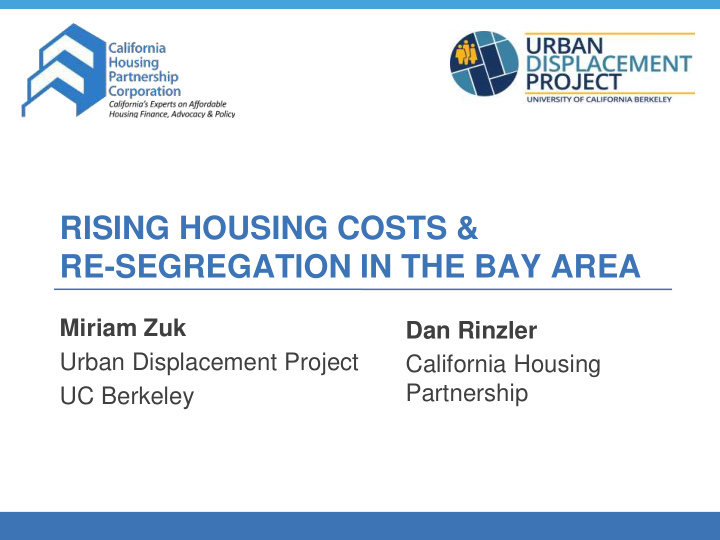



RISING HOUSING COSTS & RE-SEGREGATION IN THE BAY AREA Miriam Zuk Dan Rinzler Urban Displacement Project California Housing Partnership UC Berkeley
California Housing Partnership • Created by the State Legislature in 1988 (no ongoing state funding) • Work across California with nonprofit and government housing agencies to create and preserve housing affordable to lower-income households, while providing leadership on housing policy • In 30 years, have helped private and public housing agencies leverage $18 billion in private and public funding to create and preserve more than 70,000 affordable homes . California Housing Partnership | 2
The Urban Displacement Project The Urban Displacement Project (UDP) is a research and action initiative at UC Berkeley. UDP conducts community- engaged, data-driven, applied research to help move cities towards more equitable and inclusive futures. The goal of UDP is to produce rigorous research to reframe conversations, empower advocates and policymakers, and to train and inspire the next generation of leaders in equitable development. California Housing Partnership | 3
Frequently Asked Questions about Displacement in the Bay Area • When people get displaced, where do they go? How does the map change for different • racial/ethnic/income groups? • Is it ok if people get displaced to somewhere else in the Bay Area? • What are the racial equity implications of displacement? How does displacement relate to patterns of • neighborhood segregation and access to opportunity? California Housing Partnership | 4
Survey of Displaced Households from San Mateo and Santa Clara Counties Collaboration between UDP, CLSEPA , Bay Legal, and the Law Foundation of Silicon Valley. Funded by The Silicon Valley Community Foundation. San Mateo • 33% of household respondents left the county • Displaced to worse-off neighborhoods Santa Clara • Only 9% were able to move within a mile of previous home • 20% ended up in “precarious” housing (hotel, doubling up, couch-surfing)
Project Background • Collaboration between the California Housing Partnership and the UC Berkeley Urban Displacement Project. Funded by The San Francisco Foundation. How has the distribution low-income and people of 1. color shifted across the Bay Area between 2000 and 2015? What is the relationship between these trends to 2. changes in the price of rental housing? How have patterns of racially segregated 3. concentrated poverty & unequal access to opportunity changed over time? California Housing Partnership | 6
Three County-level Reports (September) + Regional Report (February) Download at http://www.urbandisplacement.org California Housing Partnership | 7
Interactive Web Maps Mobility by Race/Income http://urbandisplacement.org/migrationmap Demographic Change by Race/Income http://urbandisplacement.org/rentchangemap California Housing Partnership | 8
Changes in low-income households of color were spatially concentrated (2000-2015) Change in low-income Black households (2000-2015) California Housing Partnership | 9 Source: U.S. Census, American Community Survey
Low-income households of color were more vulnerable to rent increases than low-income white households 30% tract-level increase in median rent (adjusted for inflation) in Bay Area from 2000-2015 was: ➢ Associated with a 25% decrease in low-income households of color ➢ Not associated with any change in low-income White households California Housing Partnership | 10 Source: U.S. Census, American Community Survey
Cost of Displacement ➢ Low-income households who made any kind of move in 2015 ended up more rent- burdened than those who did not move. California Housing Partnership | 11 Source: ACS Public Use Microdata Sample (PUMS)
Changing landscape of high-poverty & racially segregated neighborhoods (2000 and 2015) California Housing Partnership | 12 Source: U.S. Census, American Community Survey
Changing landscape of high-poverty & racially segregated neighborhoods (2000 and 2015) California Housing Partnership | 13 Source: U.S. Census, American Community Survey
Changing landscape of high-poverty & racially segregated neighborhoods (2000 and 2015) California Housing Partnership | 14 Source: U.S. Census, American Community Survey
Displacement & migration of low-income people of color contributed to new concentrations of segregation and poverty Share of low-income households living in segregated + high-poverty tracts (2000 and 2015) California Housing Partnership | 15 Source: U.S. Census, American Community Survey
Geography of opportunity in the Bay Area “resources” = tract -level predictors of upward mobility for low-income children California Housing Partnership | 16 Source: U.S. Census, American Community Survey
Access to high-resource neighborhoods in 2015 was more pronounced between racial groups than between incomes of same race California Housing Partnership | 17 Source: U.S. Census, American Community Survey
Housing & land use policy & investments in the Bay Area should enable low-income people of color to live in any neighborhood & reduce neighborhood inequality by: Stabilizing rental housing prices in neighborhoods 1. where they are rising fastest + displacement risk is highest; Creation of new affordable homes in high- 2. resource neighborhoods; and Increasing economic opportunity and institutional 3. supports in racially segregated, high-poverty neighborhoods. California Housing Partnership | 18
Recommend
More recommend